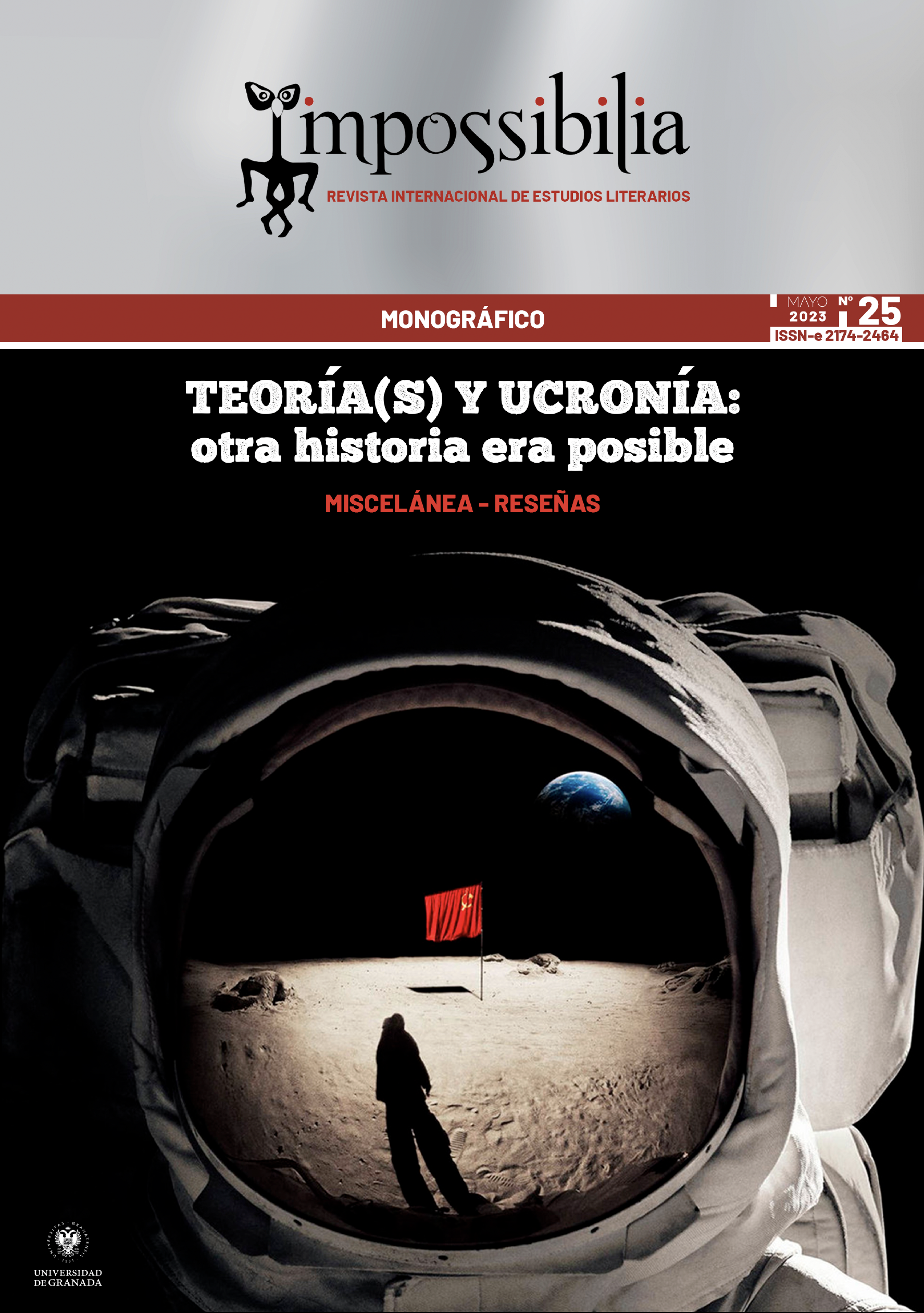La evolución cíclica del discurso de género de Charlotte Perkins Gilman: rastros de utopía y distopía en 'The Yellow Wallpaper' y "Herland"
DOI:
https://doi.org/10.30827/impossibilia.252023.26941Palabras clave:
Utopía, distopía evolución cíclica, rastro, géneroResumen
A lo largo de este artículo se argumenta que la transformación del discurso de género de Charlotte Perkins Gilman de la distopía a la utopía, ejemplificada a través de la evolución comúnmente percibida desde su narración “The Yellow Wallpaper” (1892) a su novela utópica Herland (1915), no sigue una trayectoria lineal de la opresión al júbilo feminista, sino que presenta una progresión circular. Como autora, Gilman es capaz de encontrar espacios de creatividad en muestras creativas de delirio femenino como resultado de la sujección patriarcal, así como ejemplos de subyugación en contextos idealizados compuestos exclusivamente por mujeres. Ambas obras presentan manifestaciones de opresión y de exultación, pese a haber sido escritas en diferentes etapas de creatividad de la autora y haber sido consideradas tradicionalmente como significativamente dispares en lo que atañe a su aproximación de género. Este artículo se propone delinear una tendencia hacia una evolución circular en contraposición a una progresión lineal al desvelar muestras de utopía en “The Yellow Wallpaper” y de distopía en Herland. Estas premisas se abordarán a través del análisis comparativo de “The Yellow Wallpaper” y Herland por medio de la identificación de rastros de elementos narratológicos pertenecientes a la ficción distópica y utópica en ambas obras.
Descargas
Citas
ATTEBERY, Brian. (2000). Women Alone, Men Alone: Single-Sex Utopias. FemSpec, 1(2), 4-15.
BOOKER, M. Keith. (1994). Woman on the Edge of a Genre: The Feminist Dystopias of Marge Piercy. Science Fiction Studies, 21, 337-350.
CLAEYS, Gregory; & TOWER SARGENT, Lyman. (1999). The Utopia Reader. New York: New York University Press.
CLAEYS, Gregory. (2016). Dystopia: A Natural History. Oxford: Oxford University Press.
ECK, Gregory. (2001). Utopian Literature: A Guide. HTML. http://faculty.citadel.edu/hutchisson/Pages/utopbib.htm
EGAN, Kristen. (2011). Conservation and Cleanliness: Racial and Environmental Purity in Ellen Richards and Charlotte Perkins Gilman. Women’s Studies Quarterly, 39(3), 77-92.
EVANS, Lynne. (2014). You See, Children Were the—the Raison d’Être: The Reproductive Futurism of Charlotte Perkins Gilman’s Herland. Canadian Review of American Studies, 44(2), 302-319.
GILBERT, Sandra; & GUBAR, Susan. (1979). The Madwoman in the Attic: The Woman Writer and the Nineteenth-Century Literary Imagination. New Haven: Yale University Press.
GILMAN, Charlotte Perkins. (1991). The Living of Charlotte Perkins Gilman: An Autobiography. Madison: University of Wisconsin Press.
GILMAN, Charlotte Perkins. (1998). Herland. New York: Dover.
GILMAN, Charlotte Perkins. (2009). The Yellow Wallpaper and Selected Writings. London: Virago.
GOLDEN, Catherine. (Ed). (1992). The Captive Imagination: A Casebook on The Yellow-Wallpaper. New York: The Feminist Press.
GOLDEN, Catherine. (2002). Caging the Beast: The Radical Treatment for ‘Excessive Maleness’ in Gilman’s Fiction. In GOLDEN, Catherine; & SCHNEIDER ZANGRANDO, Joanna. (Eds). The Mixed Legacy of Charlotte Perkins Gilman (pp. 122-134). Newark: University of Delaware Press.
HEDGES, Elaine. (1973). Afterword. In Elizabeth Perkins Gilman. The Yellow Wallpaper (pp. 37-60). Oxford: Oxford University Press.
HILL, Mary (1980). Charlotte Perkins Gilman: The Making of a Radical Feminist, 1860-1896. Philadelphia: Temple University Press.
HUGHES, William. (2016). Medicine and the Gothic. In HUGHES, William; PUNTER, David; SMITH, Andrews. (Eds). The Encyclopaedia of the Gothic (pp. 438-442). Oxford: Blackwell.
JOHNSON, Greg. (1989). Gilman’s Gothic Allegory: Rage and Redemption in ‘The Yellow Wallpaper.’ Studies in Short Fiction, 26(4), 521-530.
KARPINSKI, Joanne (2000). The Economic Conundrum in the Life-Writing of Charlotte Perkins Gilman. In GOLDEN, Catherine; SCHNEIDER ZANGRANDO, Joanna Schneider. (Eds). The Mixed Legacy of Charlotte Perkins Gilman (pp. 35-45). Newark: University of Delaware Press.
KESSLER, Carol Farley. (1995). Charlotte Perkins Gilman: Her Progress Toward Utopia, with Selected Writings. Syracuse: University of Syracuse Press.
KESSLER, Carol Farley. (2000). Dreaming Always of Lovely Things Beyond: Living toward Herland, Experiential Foregrounding. In GOLDEN, Catherine; SCHNEIDER ZANGRANDO, Joanna. (Eds). The Mixed Legacy of Charlotte Perkins Gilman (pp. 89-102). Newark: University of Delaware Press.
LANE, Anne. (1990). To Herland and Beyond: The Life and Work of Charlotte Perkins Gilman. New York: Pantheon.
ÖZYÖN, Arzu. (2020a). A Comparative Analysis of Feminist Approach to All-Female Worlds in Charlotte Perkins Gilman’s Herland and Joanna Russ’s ‘When It Changed.’ Atatürk Üniversitesi Edebiyat Fakültesi Dergisi, 64(1), 91-105. https://dergipark.org.tr/tr/download/article-file/1171286
ÖZYÖN, Arzu. (2020b). A Journey of Feminist Rebellion through Charlotte Perkins Gilman’s Short Story ‘The Yellow Wallpaper’ and Her Novel Herland. International Journal of Language Academy, 8(5), 115-124. https://ijla.net/?mod=tammetin&makaleadi=&key=47013
RABKIN, Eric; GREENBERG, Martin; OLANDER, Joseph. (Eds). (1983). No Place Else: Explorations in Utopian and Dystopian Fiction. Carbondale: Southern Illinois University Press.
REID, Robin Anne. (2004). ‘Momutes’: Momentary Utopias in Tepper's Trilogies. In BARTTER, Martha. (Ed). The Utopian Fantastic: Selected Essays from the Twentieth Conference on the Fantastic in the Arts (pp. 89-102). New York: Praeger.
RINGEL, Faye. (2016). New England Gothic. In HUGHES, William; PUNTER, David; SMITH, Andrews. (Eds). The Encyclopedia of the Gothic (pp. 465-468). Oxford: Blackwell.
SHOWALTER, Elaine. (1977). A Literature of Their Own: British Women Novelists from Brontë to Lessing. Princeton: Princeton University Press.
SHOWALTER, Elaine. (1985). The Female Malady: Women, Madness, and English Culture, 1830-1980. London: Virago.
TIERNEY, Helen. (1999). Women’s Studies Encyclopaedia. Westport: Greenwood Publishing Group.
TODOROV, Tzvetan. (1975). The Fantastic: A Structural Approach to a Literary Genre. Ithaca: Cornell University Press.
TOWER SARGENT, Lyman. (2010). Utopianism: A Very Short Introduction. Oxford: Oxford University Press.
TREICHLER, Paula. (1984). Escaping the Sentence: Diagnosis and Discourse in ‘The Yellow Wallpaper.’ Tulsa Studies in Women’s Literature, 3(1/2), 61-77.
TUTTLE, Jennifer. (2000). Rewriting the West Cure: Charlotte Perkins Gilman, Owen Wister, and the Sexual Politics of Neurasthenia. In GOLDEN, Catherine; SCHNEIDER ZANGRANDO, Joanna. (Eds). The Mixed Legacy of Charlotte Perkins Gilman (pp. 103-121). Newark: University of Delaware Press.
WOOLF, Virginia. (1935). A Room of One’s Own. London: Hogarth Press.
Publicado
Cómo citar
Número
Sección
Licencia
Derechos de autor 2023 Impossibilia. Revista Internacional de Estudios Literarios

Esta obra está bajo una licencia internacional Creative Commons Atribución-NoComercial-SinDerivadas 4.0.



















